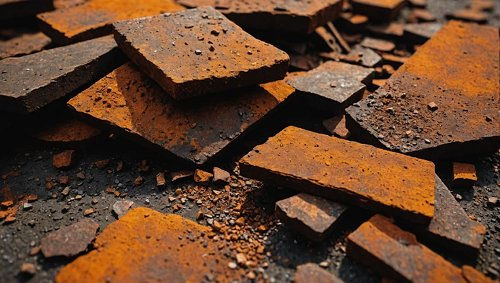Peracetic Acid: Origin, Reactions, Hazards
- Sylvia Rose

- Oct 23, 2024
- 5 min read
Peracetic acid is a remarkable compound with powerful benefits and considerable risks. A colorless liquid with a sharp odor similar to vinegar, peracetic acid can have strong corrosive properties.

Peracetic acid (PAA), scientifically known as peroxyacetic acid, is an intriguing compound in both the chemical and agricultural industries. Peracetic acid is a colorless liquid with an acrid odor similar to that of acetic acid (the main component of vinegar).
It belongs to a group of chemicals known as peroxy acids, which have a structure including a peroxy group (-O-O-). This unique structure is what makes peracetic acid a strong oxidizing agent, giving it potent antimicrobial and bleaching properties.
How is Peracetic Acid Made?
Peracetic acid can be synthesized through the reaction of acetic acid with hydrogen peroxide. The reaction typically requires an acid catalyst to facilitate the process and is commonly done in a controlled environment to ensure safety and efficiency:
[ CH3COOH {Acetic Acid} + H2O2 {Hydrogen Peroxide} --> H2SO4 {Acid Catalyst} CH3CO3H {Peracetic Acid} + H2O {Water} ]
This in-situ generation of peracetic acid can occur in various concentrations, which are adjusted depending on its intended application. During the chemical reaction of peroxyacetic acid, it produces acetic acid, oxygen and methanol.

The steps include:
Reactants: A typical mixing ratio of acetic acid and hydrogen peroxide is 1:1 for optimal results.
Catalysis: By adding a catalyst, the reaction accelerates, leading to the formation of peracetic acid along with water.
Separation: After the reaction concludes, peracetic acid can be separated and purified for various uses.
The production process allows for the creation of varying concentrations depending on the application. For instance, a 0.2% solution is often used in food sanitation, whereas a 15% concentration may be necessary for industrial application.
Does it Occur in Nature?
Peracetic acid isn't significantly found in nature. It's sometimes created in small amounts with natural decomposition of organic materials or by reactions of acetic acid with hydrogen peroxide in the environment.

Is it Safe to Mix Store-Bought Vinegar (5%) and Hydrogen Peroxide (3%) with Water?
Mixing store-bought vinegar (which contains around 5% acetic acid) and hydrogen peroxide (3%) generates peracetic acid during the chemical reaction. While some people may do this for household cleaning purposes, caution is advised.
The resulting mixture can be corrosive and irritating to the skin and respiratory system. It can produce hazardous vapors because of its volatility and strong oxidizing properties. Ensure proper ventilation, wear protective gear, and use the mixture cautiously.
Mixing vinegar and hydrogen peroxide in concentrated amounts, or storing vinegar and hydrogen peroxide in quantities subject to evaporation, thus increasing amount of hydrogen peroxide and acetic acid can cause explosive combustion.

Full strength peracetic acid explodes at 110 °C (230 °F).
What Reaction Does Vinegar Have with Iron?
When vinegar, which is an acetic acid solution, interacts with iron, it can lead to a chemical reaction that results in the formation of iron(II) acetate and hydrogen gas. This reaction is commonly used in metal cleaning processes but can also lead to corrosion of the iron, depending on the concentration of acetic acid and exposure time.
Vinegar is known for its mild acidity, which corrodes iron over time. The acidic properties lead to rust on iron surfaces, which occurs due to iron oxidizing with oxygen in moisture.
What Reaction Does Hydrogen Peroxide Have with Iron?
Hydrogen peroxide can also react with iron, mainly when it is in the presence of a catalyst or at elevated temperatures. The primary reaction involves oxidation, resulting in a variety of iron oxides, or rust, along with generation of oxygen gas. This can lead to deterioration of metals, particularly under conditions that favor high concentrations of hydrogen peroxide.

What is Peracetic Acid Used For?
Peracetic acid is used in many applications due to its effective antimicrobial properties. Some of its key uses include:
Food Processing: As a sanitizer to ensure food safety by eliminating bacteria and viruses on surfaces and pre-washing food items.
Water Treatment: For disinfecting water in municipal and industrial treatment settings.
Medical: Used in sterilizing surgical instruments and other medical equipment due to its broad-spectrum efficacy against microorganisms.
Agriculture: Acts as a biocide in agricultural practices, helping control plant pathogens and pests.
Textile Industry: Its properties are also harnessed in textiles for bleaching and fabric disinfection, maintaining quality and safety.
Chemical Syntheses: In various chemical reactions, peracetic acid acts as an effective oxidizing agent.
Hazards
While peracetic acid is highly effective, hazards are associated with its use. The compound is highly corrosive to the skin, eyes, and respiratory tract, causing chemical burns. Inhalation of vapors can lead to respiratory irritation and damage.

Due to its strong oxidizing properties, it can react violently with organic materials and other chemicals if not handled with care. Proper personal protective equipment (PPE) is essential when handling peracetic acid, and any exposure should be treated promptly.
Common hazards include:
Corrosiveness: Direct exposure to concentrated peracetic acid can lead to severe skin burns and eye damage. Always wear proper protective equipment like gloves and goggles.
Acrid Odor: The strong smell can irritate the respiratory system. Use peracetic acid in well-ventilated areas to minimize inhalation risks.
Reactive Nature: Peracetic acid can react dangerously with oxidizing agents and other compounds, leading to potentially explosive situations. Storing it well away from incompatible materials is crucial.
Environmental Impact: Care must be taken to prevent peracetic acid from entering water systems, as it can poison aquatic life.

In summary, peracetic acid is a versatile and powerful compound used predominantly for its potent disinfectant properties across various industries. However, its corrosive nature and potential hazards necessitate it be handled with caution.
Non-Fiction Books:
Fiction Books:
READ: Lora Ley Adventures - Germanic Mythology Fiction Series
READ: Reiker For Hire - Victorian Detective Murder Mysteries


